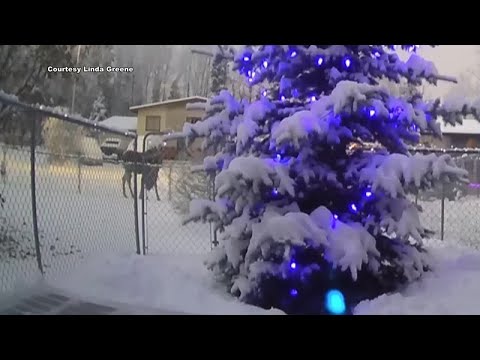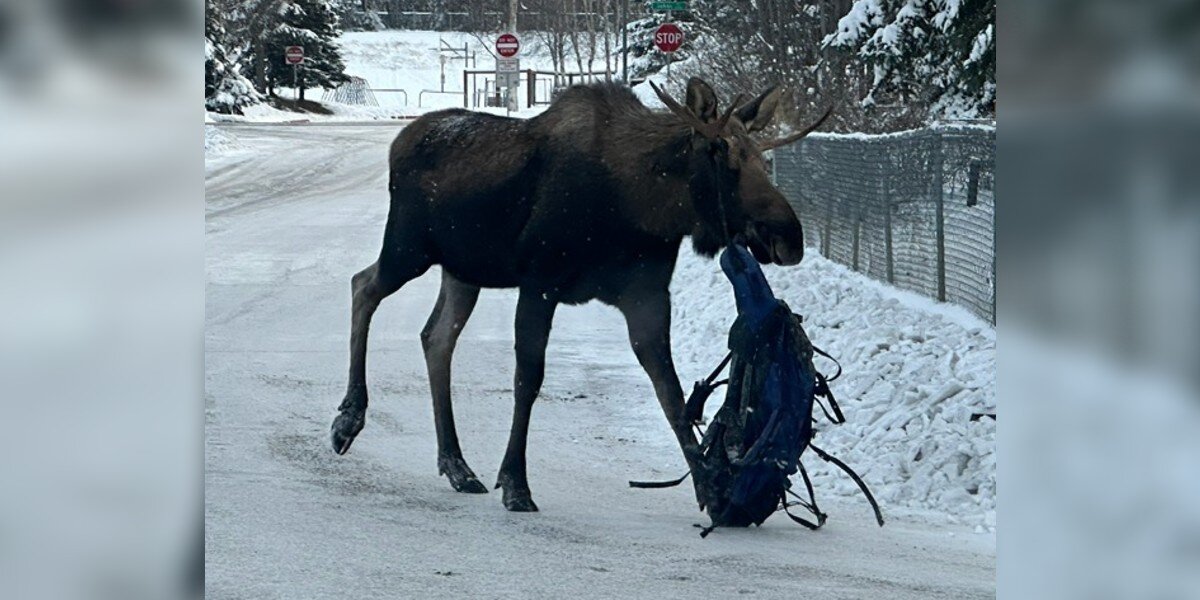Last week, a moose made his way down from the foothills of Chugach State Park and into the city of Anchorage, Alaska. Everywhere he went, the moose turned heads.
Not because he was a bull moose strolling through town — that’s quite normal this time of year as temperatures drop — but because something large and black hung from his antlers, cables swaying wildly.
 Alaska Department of Fish and Game
Alaska Department of Fish and Game
The first calls came into the Alaska Department of Fish and Game from locals who’d seen the moose but couldn’t tell what was stuck to him.
“Then we were actually able to get pictures of the moose with the object,” Cory Stantorf, an area biologist for Anchorage with the Division of Wildlife Conservation, told The Dodo. “[It] was a full-fledged internal frame backpack that was stuck on [his] antlers.”
 Alaska Department of Fish and Game
Alaska Department of Fish and Game
Internal frame backpacks are meant to carry heavy loads during long hiking trips. This particular pack was empty, but its size posed a significant danger to the moose.
“Whenever there’s anything that hinders walking, seeing or feeding, then we do our best to intervene to remove that obstacle,” Stantorf said. “Where you have roadways, slick streets, a dark moose, they need every option they have to see vehicles coming.”
 Getty Images/andyKRAKOVSKI
Getty Images/andyKRAKOVSKI
The large backpack blocked the moose’s vision on his right side, making him vulnerable to oncoming traffic or other obstacles.
Stantorf mentioned that this time of year, around the first week of December, bull moose shed their antlers. If the object hanging from his head had been small, the rescue crew could’ve left the animal alone, knowing he’d shake off the antlers in a few weeks.
Unfortunately, this backpack also posed a tripping hazard.
“As that moose was walking, he was getting his foot stuck in between straps,” Stantorf said. “Which doesn’t bode well if you’re trying to run away from a vehicle or you get spooked and you go taking off or try to run through the woods … I also don’t want him to step and fall and break a leg.”
 Alaska’s News Source
Alaska’s News Source
The Alaska Department of Fish and Game used a thermal drone to track down the moose, but he was deep in the woods, where a rescue mission would be difficult to carry out.
During the following week, sightings of the frustrated moose continued rolling in. He shook his head, annoyed at the backpack in his space.
Finally, the moose settled into a residential neighborhood for a meal. Stantorf and his team stealthily approached while the moose chewed his food and safely sedated him so they could remove the backpack.
 Alaska Department of Fish and Game
Alaska Department of Fish and Game
Everything ran smoothly: The moose went down, several team members monitored his vitals as others removed the backpack. He received an ear tag so biologists like Stantorf can better understand his habits in the future.
The team revived the moose, allowed him time and space to get his bearings and watched him wander away, a little lighter than before.
“I did see that moose that same evening,” Stantorf said. “About two blocks away from where we sedated him, he was standing on the side of the road there, feeding away.”
 Carpenter Refuses To Leave Deer Trapped In Ravine, So She Builds A Stairway Out”He knew we were there to help him.”
Carpenter Refuses To Leave Deer Trapped In Ravine, So She Builds A Stairway Out”He knew we were there to help him.”

